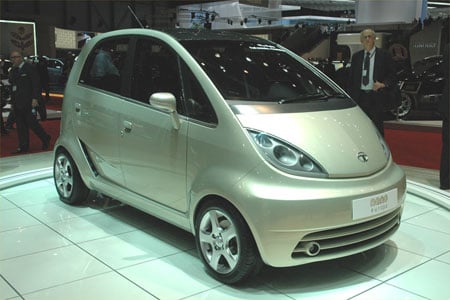Tata has unveiled a more regularly-specced version of the Tata Nano that it intends to sell in more sophisticated markets such as Europe. It will be a car that has all the creature comforts that you’d expect, unlike the 1 lakh version that it intends to sell in India which will be stripped bare of even an air conditioning unit.
This high-spec version has been exhibited at the 2009 Geneva Motor Show and is called the Tata Nano Europa. While the Indian Nano rides on a wheelbase of 2,230mm, the Tata Nano Europe has a stretched 2,280mm wheelbase and measures 3,290mm long and 1,580mm wide (the Indian Nano is 3,100mm by 1,500mm). It’s actually shorter both in terms of length and wheelbase compared to the Kancil but is wider. Powering the Nano Europe is an inline-3 fuel injection engine mated to a 5-speed automatic and it will also come with a power steering system.
[zenphotopress number=99 album=156]
| Tata Nano Europa | Viva | Kancil | |
| Length | 3,290mm | 3,575mm | 3,365mm |
| Width | 1,580mm | 1,475mm | 1,405mm |
| Wheelbase | 2,280mm | 2,390mm | 2,280mm |
Other features that the Nano Europa will get include ABS, ESP stability control and airbags, which already places it above many small cars in terms of equipment, especially the presence of stability control. Of course with all of this extra features the price will be far from the original pricetag that gave the Nano its “1 lakh car” nickname, but I doubt the European customer will accept driving something as bare as the Indian Nano. Who knows, we could even end up having this Nano Europa sold in Malaysia by the new Tata franchisee, whoever they may be.
Tata of course has other aces up its sleeve for Europe, and it begins to make sense why they acquired Jaguar once you see what else they are exhibiting at Geneva, coming soon right after this story.
Looking to sell your car? Sell it with Carro.



AI-generated Summary ✨
Comments generally express enthusiasm and curiosity about the Tata Nano Europa, highlighting its modern and appealing design compared to the original Nano. Many commenters believe this high-spec version could appeal to lower-income buyers in Europe and Asia, especially if priced competitively. Some discuss concerns about safety, spare parts availability, and the practicality of the car, while others compare it to Malaysian cars like Proton and Perodua, criticizing or defending their quality and safety standards. Several comments suggest that the Nano is a good, affordable alternative for budget-conscious families, especially in developing countries. Overall, the sentiments are mixed but mostly positive, with excitement about the potential launch and skepticism about market barriers and safety.